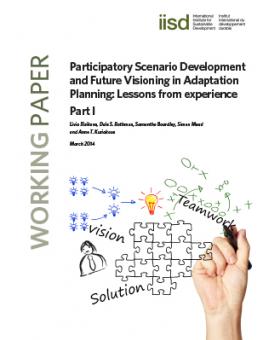
Participatory Scenario Development and Future Visioning in Adaptation Planning: Lessons from experience Part I
In this paper, we introduce and present major lessons learned from the application of participatory scenario-based tools.
We illustrate how such tools provide opportunities to increase the usability of information on climate change impacts when developing adaptation responses and exploring linkages between development, projected climate change and relevant adaptation responses. We show the type of structured processes needed that can bring together current challenges, potential future socioeconomic pathways and climate change impacts to determine how different stakeholders view the range of policy and management options available to them, and then to identify appropriate policies and adaptation actions in the context of—and across—plausible development pathways.
This paper is followed by another publication outlining specific applications of participatory scenario development (PSD) in three countries: Ghana, Honduras and Tajikistan.
Participating experts
You might also be interested in
What Is the NAP Assessment at COP 29, and Why Does It Matter?
At the 29th UN Climate Change Conference (COP 29) in Baku, countries will assess their progress in formulating and implementing their National Adaptation Plans. IISD’s adaptation experts Orville Grey and Jeffrey Qi explain what that means, and what’s at stake.
IISD Annual Report 2023–2024
While IISD's reputation as a convenor, a trusted thought leader, and a go-to source on key issues within the sustainable development field is stronger than ever, the work happening outside the spotlight is just as valuable.
How to Make Nature-Based Solutions for Adaptation Work for Everyone
Effective nature-based solutions (NbS) for adaptation start with integrated climate risk assessments. These take-aways will help practitioners plan for inclusive and sustainable NbS.
Inclusive Nature-Based Solutions for Climate Adaptation
Discover how climate change and biodiversity loss impact people differently and how inclusive nature-based solutions for adaptation can help.